KURASH: HISTORY AND SOCIAL SIGNIFICANCE
Farruh Ahmedov, International Kurash Institute
Kurash has long history. Many customs of Uzbek nation are incarnated in this sport. Scientific studies show that so initial type of sport, kurash was spread 3,5-5 thsouthand years ago. Many rare ancient findings found in Surkhan, Zarafshan and Fergana valleys, graphic art patterns drawn on rock-stones prove completely above mentioned opinions.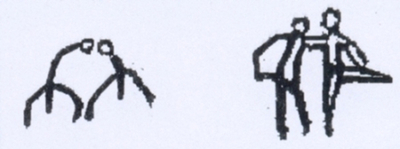
Picture 1. Rock carvings or petroglyphs found in the Tangri cave in the northern part of the Tien Shan mountain range featuring two Kurash players in action. Belongs to the Patriarchal period (more than 4 000 years B.C.). The picture from the IKA Library.
There are several examples of Central Asian nations’ folklore, including “Alpomish”, “Gurugli”, “Avazkhon”, “Rustam”, “Tulganoy”1 epos in which brave, courageous, deft and dexterous, intelligent and wise people were aggrandized. Additionally, these heroes were respected as the symbols of the nation. In that fact, deeds of nation heroes in terms of boldness and couragenousness were honored and symbolized as a perfect person.
Some valuable findings was given in the works of great thinkers, for example “Kitob al konun fit tib” (Abu Ali ibn Sina), “Shohnoma” (Firdavsiy), Temur tuzuklari” (Amir Temur), “Hamsa” (Alisher Navoi), “Boburnoma” (Zahiriddin Muhammad Bobur), “Futuvatnomai Sultoniy” (Husain Voiz Koshfiy)2. Besides, there are honorable information in the epos of Uzbek and Tadjik folklores. We can know from these sources not only about kurash, but also its features, kurash conditions and measures.
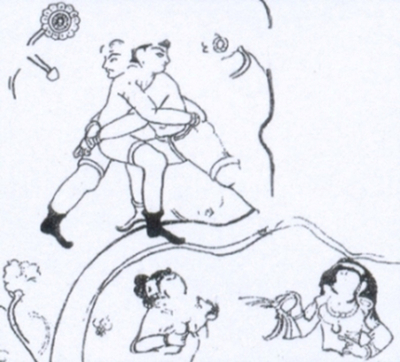
Picture 2. The wall-painting featuring two Kurash players from Sogdiana. Discovered in Samarkand, Uzbekistan. VII century A.D. The picture from the IKA Library
Kurash was reflected in folk-tales of Uzbek nation, too. For instance, we read the following sentences: “… seven years passed since then, Hasan and Zuhra grew up. Ones upon a time, Hasan played with children (fighted in kurash) and in that way he defeated all children of the country. As Hasan grew up, his strength also increased day by day. He began to defeat also older people in the homeland in fighting (kurash). Than Hasan became athletic and handsome person.
In “Tulganoy” tale, views of kurash were described. The army of Kukan Khan began to move Urta tepa. When Kukan Khan and the army of the Urta tepa were collided with each other, they did not start the battle, forces ranked in the lines. The heroes of Kukan and Urta tepa agreed with fighting in kurash. Then polvon3 Ollonazar started fighting. Ollonazar showed that kurash not only fighting or defeating opponents, but also kurash impacts soldiers spiritually and morally. Kurash contests’ have symbolic meanings, it reflects physical trainings, moral make-up fighting sides and helps to boost spiritual mood of the athletes. In “Hirs Polvon” epos, doing physical exercise has play a main role in shaping the qualities of strong man. One character of the tale says: “I have not met the strong person whose strength is equal to me. I do not want to be defeated by opponents. Therefore, I do exercise or do kurash regularly”. They show about exercises that are effective in system of physical education. For example, using the kurash technique of “Qoqma”4 by Hirs Polvon was given in this tale. It is noticeable that “Qoqma” technique is still used in today’s kurash.
The epos of “Alpomish” has a role in the folklore of Uzbek nation. The fictional ideas of these epos has vital basis, and it units with real historical events. Struggles of kurash athletes, their strength, dexterity, tolerance and knowing or using them in kurash were described in a fictional way in “Alpomish”. Material evidence found due to the investigations, explorations scientific archeological searchings and observations of historic, ethnographic and philosophic scientists gives crucial facts about kurash. Known as an initial individual sport type, kurash appeared in the area of Movorounnahr5.
It was common ritual for people who lived in that time to hold kurash competitions in the weddings, festivals or national holidays and brave, bold men used to be applauded proudly.
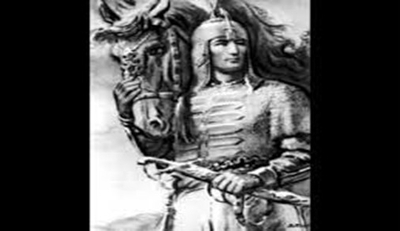
Picture 3. The picture of Alpomish
Ancient manuscripts belong to BC show that kurash had a main in general performances and national spectacles. Many written and historical monuments proud abovementioned information. For example, Elian Klavdiy6, antique scientist, pointed that in the past, Sak and Massagets7 tribes lived in the area, correspond today’s Uzbekistan territory. Kurash was widely spread among these tribes. It was usual when men were going to get married, they had to defeat their fiancées in kurash competitions. This tradition depicts even women trained kurash in that time.
A famous orientalist and ethnographer S.P.Tolstov wrote that kurash was a great importance in the history of Uzbek nation, in Eid Ramazan or Kurban Hait8 ceremonies, in the days of Navruz9 holiday. Under the leadership of eldery people, kurash competitions were held in the first three days of these holidays, people came to watch, prisoners were released, guiltes were forgiven. In fact kurash played a vital role in the lives and lifestyles of Uzbek nation.
In the period of attacks to Central Asia by Aleksandr Makedonski, social life, economy, lifestyle of people developed well. Moreover, different games and sports, physical training and athletic games were organized in Central Asia as Ancient Olympic Games in Greece. In the period of Sogdiana and Baktria’s10 forces, adroit and skilled acrobats were popular among people lived in Central Asia in BC. Adroit, battle-hardened door-keepers in physical respect went to Greece, Iran and Vizanty in order to praise about their amazing and at the same time extreme games, circus performances that were filled with pointed satire and laughter, active, flexible and unbelievable games of athletes, seething dances of hukkachi11 and wooden feet or horse dances, deep meaningly words and jokes of clowns.
In old times, community had a member of obligations and responsibilities in terms of physical training field. Young generation would have to have several qualities needed in real life, including braveness, adroitness, tolerance and definiteness. Famous Grecian historian Kwint Kurtsiy Ruf wrote that the army of Aleksandr Makedonski captive 30 strong athletes during conquering Central Asian’s areas. It was clear to kill captives. Knowing their sorrowful fate, they kept themselves brave, began to sing songs, danced with one another. Because, of their such actions, the captives were appraised highly by Aleksandr Makedonski and he decided to save their lives. Though many years or centuries passed since then, historical folktales and legends still do not lose their importance.
Arabs invaded Middle Asia (VII-VIII centuries), continued to move nearer to Samarkand city, but they were not able to enter there. Then, Arabs made a hole through the wall of the city. The way for city was opened. However, on the hole of the wall a strong man appeared suddenly and blocked the hole which caused them not to conquer the city in a long time, further, the killed many of the enemies with his sward. At that time Arabian Khalifa Kutayba announced to donate 1000 dirham12 for the person who bring that strong man’s head. Afterwards, enemies pounced crowdedly and strong man perished in this incomparable battle. Unfortunately, the name of that hero was unknown in history. Despite this, his heroic deeds were preserved among nations and he is still known for today’s people.
We can know about the kurash history from the literatures of past life. For example, in “Shohnoma” epos of Abulkhasim Firdavsiy, nation honour strong, brave men grew and challenge them to from enemies. Furthermore, kurash was a main importance in the epos of “Gulistan”, Sadiy Sheroziy. The author wrote about a person who aware of how to fight and knew 360 kurash techniques, therefore he used different techniques of fighting in each days. He thought 359 throwing techniques of struggling to his one follower. However, he kept the secret one of his technique from his follower. The student regarded that he knew all tricks and nobody showed resistance to him.
And so, there were lot of types of wrestling in nation. There were even teachers (coaches) teach these wrestling types to young generation, however, the description of these wrestling types are not known for us. For example, Mahmud Koshgariy, historic and linguist, wrote his book (“Turk og’zaki va yozma ijodiyoti to’plami”). This book gives us crucial facts about different types of wrestling. He pointed about kurash belt, uniform and athletes’ physical capacities. He wrote that athletes must be strong, flexible and elastic. He listed some ancient strong athletes (polvons).
Academic A.Askarov says by presenting some interesting information about ancient kurash athletes: “Famous kurash athletes had a special sign on their wrists who come to the gilam12 to fight. If the athlete were women, the sign would be in the neck of them. This tradition was seen in the source of ancient Kirgizs, too. Signed boys and girls were considered the most powerful, strongest and famous among the kurash athletes. In daily life they would cover their sign under the dress and other people did notice the sign. When they come to the field (gilam), their sign were visible to opponents and it made them hesitate. Many spectators applauded more signed athletes”.
Uzbek people consider that kurash is a means of the upbringing of person. Actually, kurash athlete who had strong, endurance, became strong-willed and brave or incarnated moral pureness of hard-working people were deeply-respected. According to the historical rules struggle time were not limited and athletes were chose their contestants with their appearance. Before the fight they used to do light exercises or massages their body. The kurash uniform was traditional.
As we pointed before, there were different types of wrestling in ancient territory of Uzbekistan. According to the rules of “Fergana” style, kurash athletes wore cotton clothes namely “chopon”, while they athletes from “Bukhara” style used to wear oriental robe without cotton in competition. In addition, they were required to wear traditional trousers namely “ishton” and special shoes. Usually, kurash athletes fight without shoes. This traditions wearing exists in today’s kurash, also. It is started in ethnographic investigations that kurash was early development in the area of Uzbekistan and it was common for people to organize kurash matches in weddings or general community performances.
Ancient sources or manuscripts give irrefutable evidence about kurash athletes. Many fighters (polvons) were world-famed in terms of trying one’s strength, raising heavy things, and outstanding heroism, therefore they became well-known among nation and countries, finally named “polvon”.
It was written that many kurash competitions were held in the areas of Uzbekistan X century AD. It was noted in ancient Chinese manuscript that the people of Fergana organized competitions by being divided in two groups on Navruz holidays. Other fact is that, according to the information of Maksudiy, Arabian geographer and traveller, belong to X century, that there were also similar customs to hold kurash struggles in the big cities, coupled with Marv, Samarkand and Balh14. Indeed, people gathered in one place in accordance with their wishes and willingness and arranged such competitions on Navruz holidays.
There were different types of the wrestling in ancient borders of Uzbekistan territory, some types were embodied in it and became famous under the name of kurash. These types were differentiated from one another according to the rules or usages in practice, and their fighters wore special uniform “yaktag”, “chopon” or belts on wrists. Definitely, the action of kurash were done by holding somebody by the belt.
Fighting two men pictured in the thin border b order of silver ladle that belongs to the middle of the first thousands years ago. Scientists confirm that this silver ladle appertains to ancient Vizanty. Also, several items that found Chelak village15 near Samarkand gives valuable information. Among geometrical patterned carvings, silver handled package is the most attractive. On the handle of its, two fighters were fighting in kurash. This finding belongs to first middle ages which means that kurash has a long history.
Some opinions about kurash and physical training were reflected in the points of Ibn Sina. Ibn Sina was able to give correct instructions to the fighters in the field of utilizing methods of physical training. The amount of physical training and defining it was seriously paid attention by this famous philosopher. Furthermore, he equally illustrated the organs of physical training according to the condition of it. When organs would be temperate, the temperate body would be suitable for it. If it is necessary to make weak bodies strong, these organs should do exercises a lot. The strong and through points, knowledge of Ibn Sina about physical training have been successful for coaches.
Pahlavon Mahmud has huge significance when it is talked about the development or history of kurash. Although he was a fur-tailor, Pahlavon Mahmud was a good in kurash and never failed. In fact, he was a great philosopher and poet lived between XIII and XIV centuries. He was born in 1248 year near Khiva (Khorazm) while his family was moving from Urganch to Khiva. Pahlavon Mahmud grew up physically powerful and he trained with kurash. He fought in a lot of kurash competitions and became winner held in the cities of Khorazm together with India. Therefore, Mahmud was well-known with the name of “Pahlavon”16.
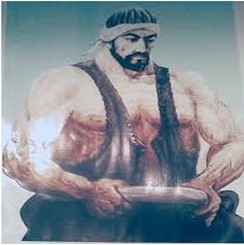
Picture 4. Photo of Phakhlavon Makhmud
According to stories, Pahlavon Mahmud saved the live of Roy Ropoy Chuna, the king of the India, in one of the wars. Then, in return for this, he made captives who were Khorazm release from India. An ardent patriot built a number of gravestones for the warriors, died in the war happened near Khiva against the army of Chingizkhan.
Because of being physically strong, many cowards were afraid of him. However, Pahlavon Mahmud was naturally modest fellow.
We can’t imagine kurash without the Great Amir Temur! During the period of great Amir Temur and his powerful dynasty culture, science, art, cottage craft and military fields were hugely developed. Especially, Amir Temur put a lot of emphases on making progress of military.
According to the historical evidences, he had no equal in terms of kurash, measuring strength or swords, shooting an arrow, and riding horse. Kurash was an inseparable part of Amir Temurs soldiers and their exercises. On the grounds of the Marcel Brion, French poet and historian, Amir Temur was incomparable in kurash and he was courageous, had a character of appreciating bold warriors. Even, there were such situations at wars that soldiers had to fight against enemies without weapons individually. Also, Temur made some important notes about kurash in his autobiography.
Being overthrown of the kingdom of Amir Temur led to cease exist experience and achievements. After that, it was pointed at historical sources or manuscripts that Bobur trained with kurash and he thought the secrets of fighting to his warriors. As a result of leaving for India and reigning there, kurash began to be spread over India and developed.
According to written notes by Gulbadanbegim, the daughter of Bobur, women wore dresses that suitable for triumphal days and they attended actively in riding horses. Also, Gulbadanbegim wrote about women’s name who sat in beside of kings in triumphs and their abilities in diverse craftmanship and skills or capabilities in playing different musical instruments.
THE PHILOSOPHY OF KURASH
It’s true that kurash has great importance in upbringing healthy generation. In every respect, strengthen defensive might of the country and improving military service. Obviously, kurash is the most valuable that plays a vital role in shaping unanimous nation. Not only kurash is the skills of fighting physically with opponents, but also bring up youth in the spirit of humanity and culture. Kurash is incarnated with the following ideas that this sport teaches to admit bravery, honesty and integrity, victory and failure and to respect the opponents, coaches, spectators and referees. In this chapter of this guide, the book will say about philosophy and social importance of kurash.
Kurash helps to upbringing every young people in spirit of being patriotic to his or her Motherland and loyal to the country. How the kurash athletes are patriotic, or how much they have loyalty and honesty, their spirits in the kindness to their Fatherland to will be clarified in the process of doing exercises, preparing for crucial competitions, esteeming themselves during the results of the games.
Athletes who are never be defeated are presenting this perfectly and showing examples by this how they are in patriotic and humanity spirit. In reality, kurash is considered as a means of upbringing young people in physically hardening.
Of course, firstly, kurash was valuable custom of Uzbek nation, which caused to develop completely, secondly, kurash has a vital role in shaping young generations to be spiritually perfect. Since the tendency and ideas are fair, it rises the feelings of person to higher degree. Indeed, kurash is connected with the life of Uzbek nation spiritually as being existed in heredity of Uzbek people.
As we know that in the worldwide all countries are putting emphases on raising youth healthy and intellectually skillful in every respect. In the system of Education, Healthcare, Sport and other different spheres in society are becoming wanted consequences in both enhancing and developing education system. The necessity of working out efficient organizational-pedagogical factors based on national and global traditions and customs is widely illustrated in some special programs. In return for these chances together with kindness and attention, young people should have a duty to achieve higher results by showing their real abilities in international tournaments and Olympiads.
The role of the types of national sports, especially kurash is huge in terms of bringing up spiritually-perfect and creatively-intellectual generation.
The long history of kurash was glorified as sample for perfection of athletes. A physical strength, adroitness aspects, behaving modestly among people, conducts, spiritual appearance, the attitudes towards opponents, referees, carpets and spectators together with other characters of kurash athletes have a special significance.
A lot of legends were created about kurash athletes in ancient times. Being athlete in nation is cultural and great heritage. This custom and heritage is still deeply-esteemed and will respected in the future, also. In today’s world, lot of countries are paying attention to respect athletes and appreciating them in a wide respect.
The philosophy of kurash is, today hugely comprehensive. It corresponds with the cultural aspects of physical training. In this field, some scientists have carried out different investigations (for example, Uzbekistan, India, Turkey and others). In particular, they gathered a great deal information about learning scientific, philosophical, social and cultural knowledge of kurash. Several scientists such U.Ibrokhimov (died) and J.Toshpulatov (Uzbekistan, Surkhandarya), A.Atoev (Uzbekistan, Bukhara), F.Akhmedov (Uzbekistan, Jizakh) gave crucial information about philosophical and pedagogical aspects of sport, especially, kurash in their researches.
Divers views and opinions about kurash were notified in international and national meetings and conferences. The works of academic F.Tulenov, professors M.Murodov, U.Koraboev, I.Jabborov, T.Javliev, Kh.Homidov, O.Musurmonova, M.Davletshin, F.Nasriddinov, T.Usmonkhujaev and R.Abdumalikov are absolutely essential.
Organizing the development not only among young generation but also elderly people is leading to be formed healthy lifestyle. Kurash is being developed step by step between youth since it is unseparable part of the culture and life.
People confess that the role of kurash in upbringing of the person is pedagogically high. In order to prove abovementioned opinions and views, clarifying the conditions of kurash is suitable. Firstly, making a bow (tazim) before the contest for each other is a symbol to show the most honorable virtues of humanity. Opponents bow each other means that they are opponent only over the “gilam”. These actions are embodied with the strong respect towards one another.
THE SPIRITUAL, CULTURAL AND MORAL IMPACTS OF KURASH
Kurash means fighting, discussing and arguing. Kurash contains actions and conditions which include special physical exercises. Together with this, a special character of kurash is hugely important in growing up of the person. The development of the society leads to improvement of the culture. In today’s life, kurash has a huge significance in society.
In recent years, investigations directed to learn the aspects of sport and its role has been in high degree in the lifestyles of people. Over this issue, the specialists of physical training and sport, psychologist have carried out studies and achieved different scientific, methodological and theoretical resources in diverse degrees (V.D.Panachaev, N.I.Ponomarev, L.P.Matveev, Y.Masharipov, R.S.Salamov, L.I.Lubisheva).
Towards athletes who won in competitions and tournaments “athlete”, “winner” and “champion” words were widely used to describe them. Most people were envious of these fighters, as a consequence, great enthusiasm appeared in ordinary people to participate in kurash competitions. Usually, people have a tendency to appreciate kurash as a symbol of winners and champions.
It is clear that sport has some special and general functions. According to the theory of sports there some tasks in sport, a competition task, a healthy task, an idea task, an ethic task, an educational and moral task, a social task, a social and political task, an international task. As well as, it is noted in certain resources that sport plays a major role in bringing up patriotically. Sport is just not to define the results, or to show abilities of physical opportunities, but also it is connected with human upbringing and it is a human factor. Being received as an international sport and being improved over the respect years, kurash has been regarded as a suitable for general standards.
As it pointed in the law of the Republic of Uzbekistan “About Physical training and sport” National types of sport and national games are indivisible part of physical training and sport in the field of cultural heritage of the Republic of Uzbekistan, further sport paves the way for upbringing the youth in spirit of attempting to spread the reputation of the country. It is real that national sport types, social development and shaping them are interconnected with bringing up young generation in a patriotism mood. For example, kurash contains respecting opponents, defending self-esteem on the base of philosophical and moral opinions. The ideas of patriotism, humanism, peace and peace-loving and making nation industrious are incarnated in a historical development and formation of kurash. For, peace, patriotism, humanism, industrious have been appreciated and honored as a national value.
As kurash is a humanitarian value, it is reflected in character of humanism. Simply, it can be seen that kurash is just type of sport after particular preparation of athletes or attempts to defeat one another in competitions. However, the rule of competitions and general standards of kurash have such requirements for kurash athletes, referees, coaches and other participants that in competition process will be formed and brought up in accordance with sport programs and values of humanity. It is vitally essential to hold sport competitions, physical trainings without any damages to the health of spectators and participants. It is prohibited to use dangerous methods to prepare that might cause injuries or humiliation of sportsmen’s honor and virtues.
The rule of kurash competitions are worked out in special way that athletes must obey the rules. At the same time, kurash respects its high humanism character.
In the world, keeping the health of people is satisfying condition and improving it perfectly is a basic duty of medicine. There is a notion in the medicine world that “Instead of treating disease, it is more preferable to prevent it”. In contemporary life, where technology has been advanced, being passive (because, many things are done by technology) brings are about several issues, especially disease, including obesity. Doing exercises regularly on the bases of schedule provides the organism of the body with necessity to be active. Then, wanted consequence, including healthy organism and strong body can be achieved. This is one of the important reason why kurash is deeply valued as humanism.
Today’s global circumstance is resulting in different negative issues, coupled with terrorism, religious extremism and illegal drug trafficking. These problems hardly fail to affect the life of people, society and country. Modern kurash is trying to bring up every kurash athlete or participant in accordance the goal, not just to get higher results from training or competitions.
Modern Olympic Games’ propagandist prominent French statesman Pierre de Coubertin organized Olympic Games which was a great importance for humanity and it was received as a means of educating and upbringing. After a second Cold World War, organizing Asian Games owing to enterprising of India was about enhancing welfare programs, keeping the peace and unanimity among the nations. Therefore, people should have a duty to develop kurash and value it as humanism character.
In order to propagate this propaganda, it is crucial to make kurash more common among people. Especially, arranging to show scientific-methodological bases of kurash, and organizing investigations about the theory of kurash and its methodology. Briefly, the knowledge of kurash should be developed. The created land written literature of kurash has made great contribution to the development of kurash. However, to reach fast-term development in the field of sport requires to add kurash in Olympic Games and creating more successful literatures about kurash and investigations. It can be said proudly that there are any opportunities to enhance and improve science, education, sport and other fields.
Carrying out different studies and organizing investigations are becoming a major factor and they are a huge crucial task for coaches, referees, scientists and specialists in these days. Since, the world should know that kurash is the oldest type of wrestling and under the meaning of kurash, there are honesty, bravery and patriotism that are the most valuable virtues for people.
References
- K.Yusupov. (2005). International Kurash rules, technique and tactics. Tashkent., “Gaful Gulom”, p. 132.
- J.Toshpulatov. (2008). Uzbek Kurash., UzSUPE, p.35.
- J.Toshpulatov., R.Mustafokulov. (2007). Tashkent., “Yangi asr avlodi”, p.121.
- H.Bobobekov., M.Sodikova. (2002). The fame of uzbek kurash., Tashkent., “Abu Ali Ibn Sina”, p. 88.
- T.Achilov. (2014). Technique and tactics of national kurash types. Tashkent. p. 45.
- A.Ruziyev., N.Azizov. (2010). History of Uzbek national bel olish kurash. Tashkent. p. 63.
- A.Otoyev., M.Mahmudov. (2008). Popular Bukhara polvons. Tashkent., p. 41.
- S.Tursinov (and others). (2015). Uzbek national kurash: history and traditions. Termez., p.23.
- F.Akhmedov., A.Abdulakhatov. (2017). Uzbek kurash – a masterpiece of national and universal values. Tashkent., p. 128.
- A.Atoyev. (2005). Teaching methods of uzbek kurash for juniors. Tashkent. p. 146.
- F.Kerimov. (2004). Theory and methods of sport wrestling. Tashkent. p.285.
- Khaitov, Olimjon & Abdulakhatov, Akramjon & Norboyev, Komiljon & Kulbulov, Farkhod & Azamkhonov, Oltinkhon & Ahmedov, Farruh. (2020). KURASH: HISTORY, THEORY AND METHODICS. 10.37057/M_9.
- "History of Kurash". International Kurash Association. Retrieved 30 August 2016.
- Ahmedov, Farruh. (2021). Importance of analysis of competitive activity of kurash athletes.
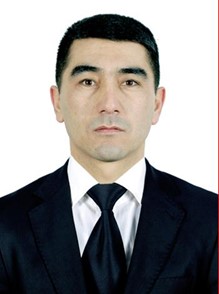
Author: Farruh Ahmedov
Publications on Kurash
Hayitov, O., & Akhmedov, F. (2018). CLASSIFICATION OF TECHNICAL MOVEMENTS OF KURASH. In Актуальные проблемы теории и практики физической культуры, спорта и туризма (pp. 686-689).
Farruh Ahmedov Olimjon Khaitov, Akramjon Abdulakhatov, Komiljon Norboyev, Farkhod Kulbulov, Oltinkhon Azamkhonov. KURASH: HISTORY, THEORY AND METHODICS. Manual. 52 pages. Published Primedia E-launch LLC.
Ahmedov, Farruh. (2021). Importance of analysis of competitive activity of kurash athletes.
Akram Abdulakhtaov, Farruh Ahmedov. ЗАМОНАВИЙ КУРАШ ВА УНИ РИВОЖЛАНТИРИШ МАСАЛАЛАРИ. THE INTERNATIONAL SCIENTIFIC AND PRACTICAL CONFERENCE "THEORETICAL AND PRACTICAL PROBLEMS OF THEORY AND METHODOLOGY OF PHYSICAL EDUCATION AND SPORT" January 29, 2022, 1412-1413.
Akram Abdulakhtaov, Farruh Ahmedov. ПРОФЕССИОГРАММА СУДЬИ ПО КУРАШУ. Collection of materials the All-Ukrainian scientific-practical conference with international participation «Physical culture in university education: innovations, experience and prospects for development in modern conditions». 11 May 2022, Dnipro. 206-209.

